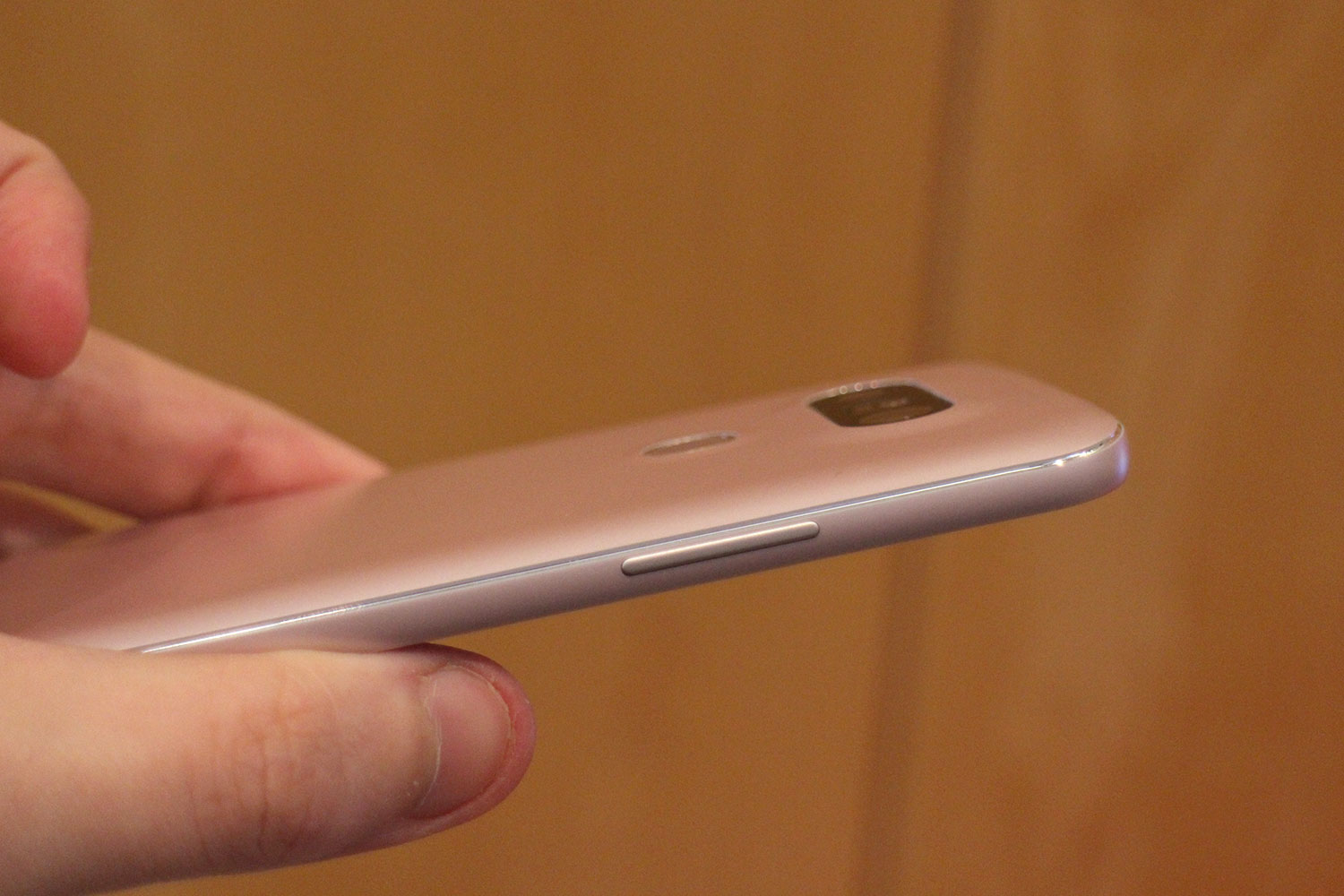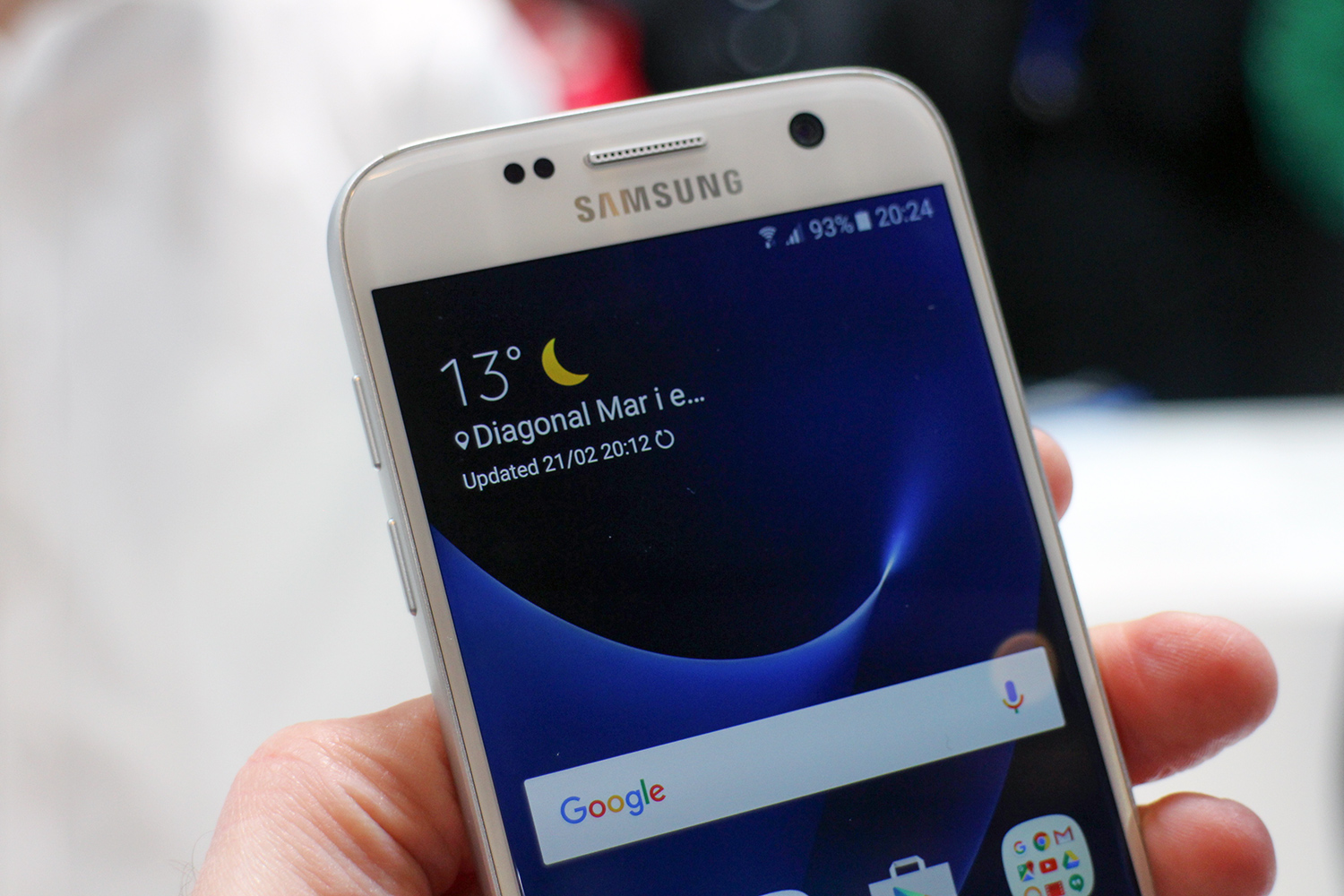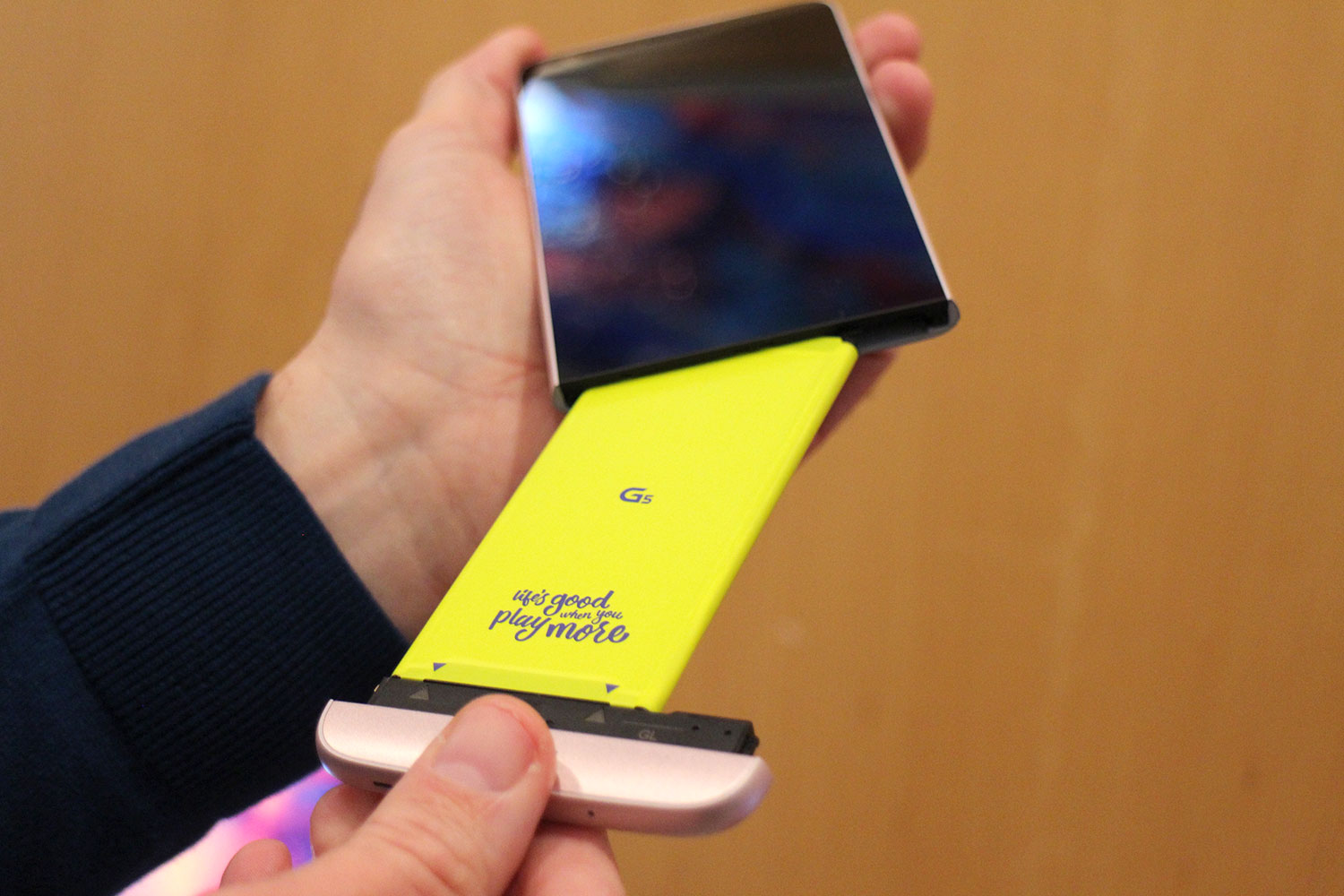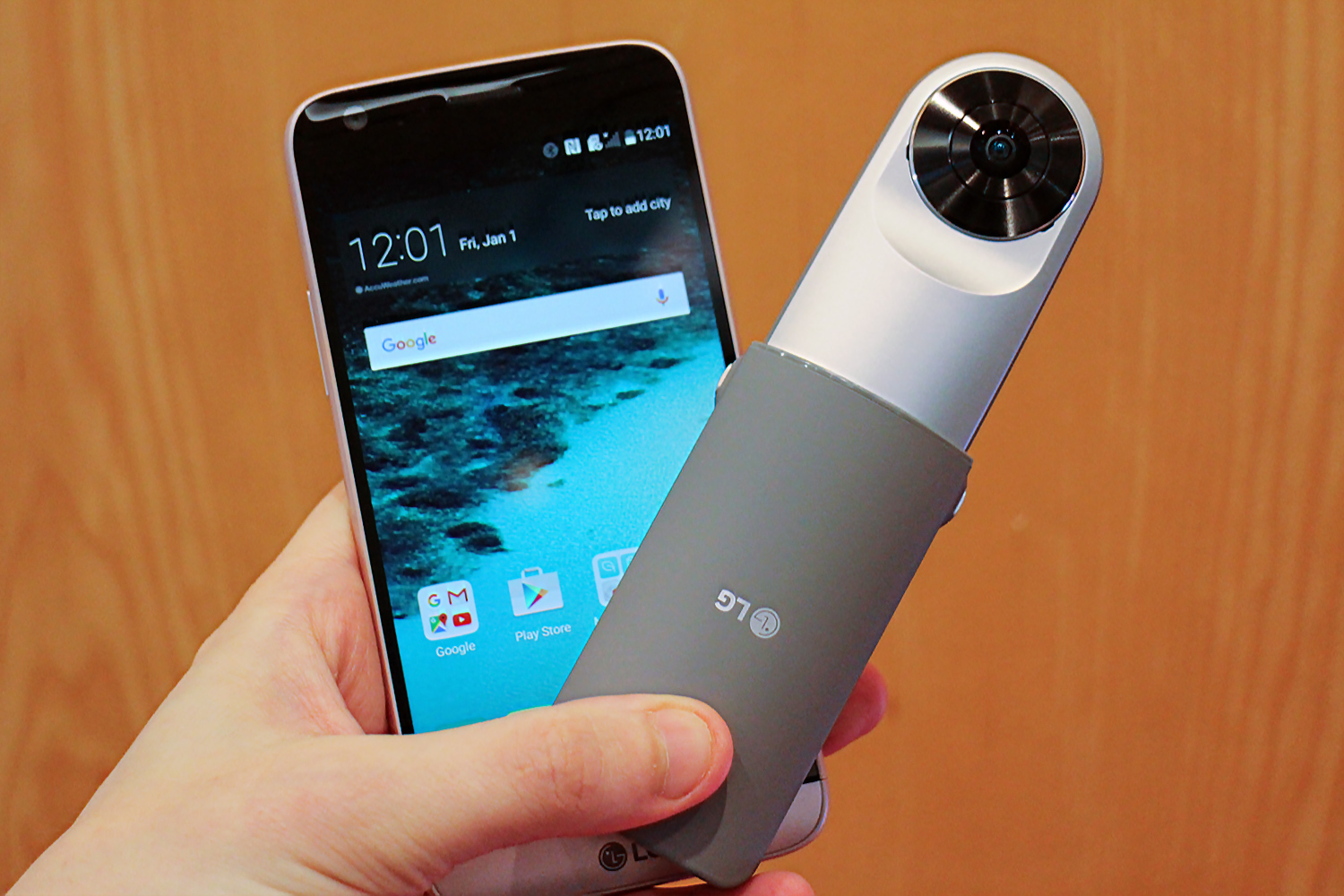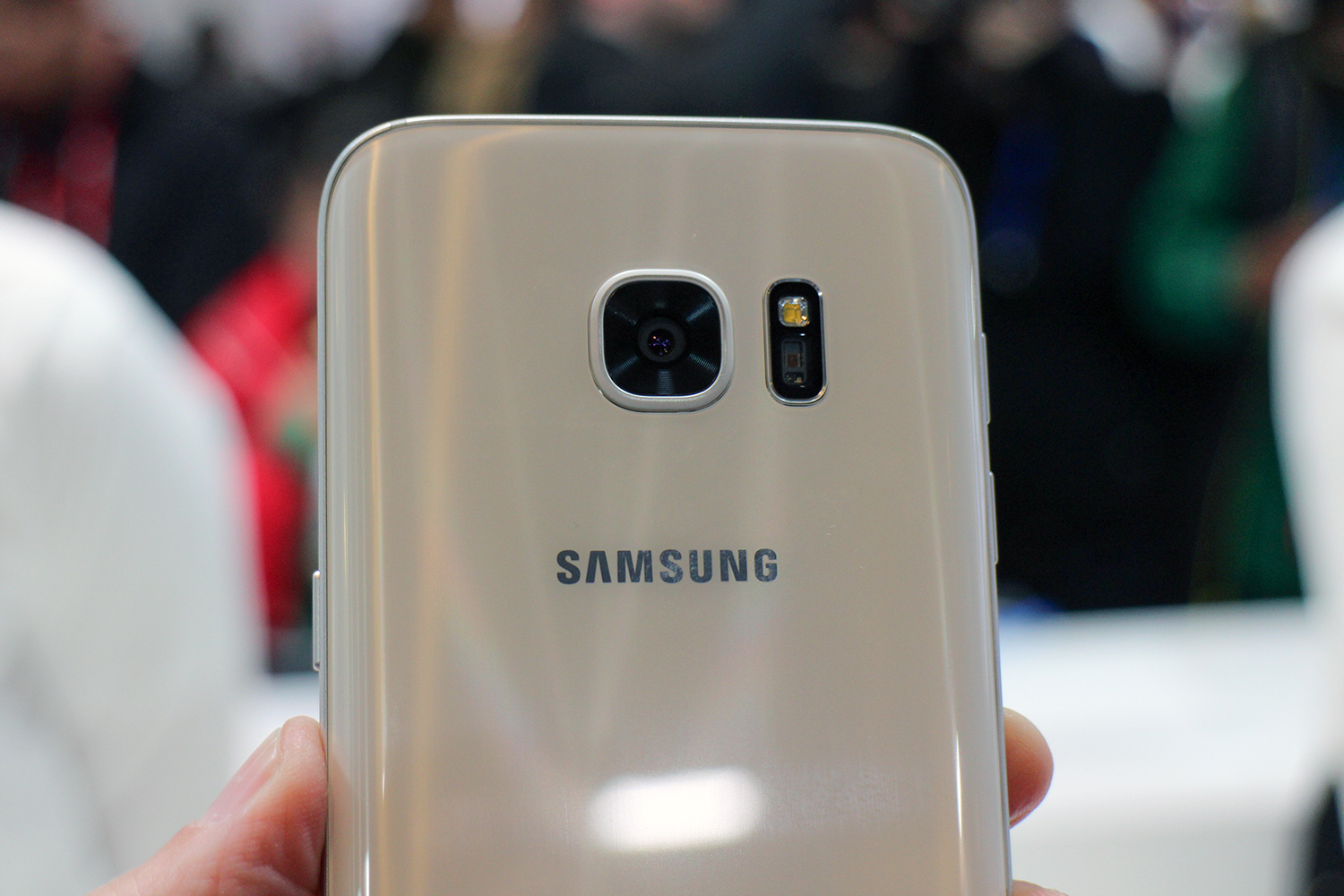If you want the latest and greatest Android phone, you’re likely looking at the Samsung Galaxy S7 or LG G5 . Available this spring, both phones sport the highest-end specs and features you could ever want in a smartphone. The big question is, which should you buy? We’re about to make your decision a lot easier with our in-depth comparison between both powerhouses.
Spec comparison
| Samsung Galaxy S7 | LG G5 | |
| Size | 142.4 × 69.6 × 7.9 (mm) | 149.4 × 73.9 × 7.7 (mm) |
| Weight | 152 grams | 159 grams |
| Screen | 5.1-inch Quad HD Super AMOLED | 5.3-inch IPS LCD Quad HD quantum |
| Resolution | 2,560 × 1,440, 577 ppi | 2,560 × 1,440, 554 ppi |
| Always On Display | Yes | Yes |
| OS | Android 6.0.1, with TouchWiz | Android 6.0.1 with LG UX |
| Storage | 32GB | 32GB |
| SD Card Slot | MicroSD, up to 200GB | MicroSD, up to 2TB |
| Processor | Quad-core Qualcomm Snapdragon 820 | Quad-core Qualcomm Snapdragon 820 |
| RAM | 4GB | 4GB |
| Connectivity | Wi-Fi 802.11 a/b/g/n/ac, MU-MIMO, LTE, HSPA+, USB 2.0, NFC | Wi-Fi 802.11 a/b/g/n/ac, LTE, HSPA+, USB Type C, NFC |
| Bluetooth | Bluetooth 4.2 | Bluetooth 4.2 |
| Sensors | Accelerometer, ambient light, barometer, Geo-magnetic, gyroscope, proximity, hall, heart-rate | Accelerometer, ambient light, compass / magnetometer, gyroscope, proximity |
| Fingerprint Sensor | Yes, front home button | Yes, back panel |
| Battery | 3,000mAh | 2,800mAh |
| Rear Camera | Dual Pixel 12MP with OIS and f/1.7 aperture | Dual rear lenses – 16MP main and 8MP wide-angle (135 degrees) with OIS |
| Front Camera | 5MP with f/1.7 aperture | 8MP |
| Quick Charge | Yes, Quick Charge 3.0 | Yes, Quick Charge 3.0 |
| Wireless Charging | Yes, Fast wireless charging | No |
| Waterproof/Dust Rating | IP68 | None (perhaps more vulnerable than a normal phone due to modular design) |
| Colors | Black Onyx, Gold, Platinum | Silver, Titan (charcoal), Gold, Pink |
| Expansion Modules | No | LG Cam Plus & LG Hi-Fi Plus with B&O Play |
| Marketplace | Google Play | Google Play |
| Average Price | $670+ | N/A |
| Availability | Pre-orders start Feb 23, in stores March 10, 2016 | Spring 2016 |
| DT Review | Our Full Hands On | Our Full Hands On |
Pre-order the Galaxy S7 at: Samsung, AT&T, T-Mobile, Sprint, Verizon
Design, beauty, and comfort
LG decided to do a complete overhaul with the G5, while Samsung left the S7 with a familiar look. The G5 now sports a unibody all-metal design that is unique in more ways than one. For starters, you won’t see the plastic antenna bands found on other phones thanks to a process the company calls “micro-dizing.”
Another first is the ability to swap out modules at the bottom of the phone. Normally a unibody device cannot feature a removable battery, but the LG G5’s bottom pops out like a drawer, revealing the battery. And swapping the battery is only the tip of the iceberg: There are two optional modules available at launch — the Cam Plus and the Hi-Fi Plus — and more on the way.
The Cam Plus module adds a better grip when taking photos and turns the G5 into a more traditional camera by adding physical buttons for power, shutter, video recording, and zoom. It also sports a 1,200mAh battery, which extends the life of the 2,800mAh battery that’s already in the phone. The Hi-Fi Plus module is for sound connoisseurs, offering support for 32-bit, 284KHz high-definition audio playback.
In terms of design, the Galaxy S7 looks very similar to the Galaxy S6 other than a few minor changes. For example, the rear camera bump isn’t as pronounced. Just like last year’s Galaxy S6, the Galaxy S7 sports a metal frame with a glass back. It’s also a unibody design, but it doesn’t offer the ability to remove the battery or swap out modules.
Samsung made big strides in comfort, and its new phones are much more holdable than last year’s, especially the Galaxy S7 Edge. Last year’s Edge was certainly gorgeous, but very uncomfortable in the hand. This year, it’s a night and day difference. We almost prefer the Edge to the standard S7, and both nestle comfortably in your palm. It’s also so well-designed that it’s waterproof, which we’ll get into later.
Still, we have to give the edge to the G5 in terms of design. Whether you prefer metal or glass, you can’t deny that LG hit it out of the park when it comes to innovation. There’s no other all-metal high-end phone on the market that gives you the ability to remove the battery or swap out modules. We can’t discount the waterproof and dustproof abilities of the Galaxy S7 — this is a very important feature. But we still have to give a slight nod to the G5.
Winner for design innovation: LG G5
Winner for comfort and beauty: Galaxy S7
Water resistance and durability

If there is one clear advantage for the Galaxy S7, its the IP68 environmental rating, which means it can be submerged in up to 1 meter of water for 30 minutes and can withstand a dust attack (or a trip to the beach). Water resistance was a Galaxy S5 feature greatly missed in the Galaxy S6, and we’re very glad Samsung brought it back.
The caveat is that the entire phone is covered in curved glass, front and back. This makes it more prone to cracks, fingerprints, and scratches. Because that glass is curved, it might also be somewhat expensive to repair.
The LG G5 is not water resistant. In fact, it might be more vulnerable to water than any modern phone. There are no rubber seals around its removable module, which makes us worry that it is extra easy for water and dust to get inside the G5. We also don’t know how it will stand up to drop tests, since it’s essentially two pieces instead of a single unibody frame like the Galaxy phones.
Overall, neither phone blows us away from a durability perspective, but we’re giving the edge to Samsung because of its waterproof body and strong, rigid frame.
Winner: Galaxy S7
Display
You’ll find Quad HD screens on both phones, which equates to a resolution of 2,560 × 1,440 pixels. But if size is really your thing, the LG G5 has the edge with a 5.3-inch display versus the Galaxy S7’s 5.1-inch display. LG uses IPS LCD technology, while Samsung uses AMOLED. There will be little to complain about with either display, but the AMOLED display on the Galaxy S7 means colors are likely to pop a little more than on the G5. AMOLED screens also allow for deeper blacks because individual pixels can turn completely off, making them as dark as possible. LCD screens are incapable of this, but do tend to show brighter whites.
Both phones feature always-on displays, meaning you can see notifications without turning the phone on and unlocking your screen. Both renditions supposedly offer minimal impact on the battery, but we can’t verify that until we spend more time with each device.
The winner in this category comes down to size preference. If you prefer the largest display possible, the G5 is your choice, but 0.2-inches isn’t significant enough to sway us either way.
Winner: Tie
Power
Both the Galaxy S7 and G5 feature the same processor, the Qualcomm Snapdragon 820. It’s a quad-core chip made up of a dual-core, 2.15GHz Kryo CPU and a dual-core, 1.6GHz Kryo CPU. Both phones also sport 4GB of RAM.
We don’t expect to see a noticeable difference between the two phones, since the processors are identical, so software will be the key. One phone could be slightly slower or faster based on how well tuned the add-on software is. Samsung’s TouchWiz has been known to cause issues, but it has been improving each year.
This one is too close to call.
Winner: Tie
Battery, charging, and storage
The Galaxy S7 has a 3,000mAh battery and the Galaxy S7 Edge has a 3,500mAh battery; the G5 includes a 2,800mAh unit. Samsung wins when it comes to size by 7 percent, which might not seem like much, but lets face it: Every little bit helps. The Galaxy S7 also sports an AMOLED screen, and Samsung has developed a special liquid cooling system to help keep systems cool, both of which could positively impact overall battery life,
However, the G5 has the advantage of featuring a removable battery. This means that you can carry extra batteries and never have to worry about running out of juice. That does come at an extra cost, though. We don’t yet know the price of extra batteries, or how easy they will be to obtain. And Samsung is releasing its own battery case, which can double your battery life.
Both phones offer fast charging thanks to Qualcomm’s Quick Charge 3.0, but Samsung also offers fast wireless charging. Wireless charging isn’t usually a deal breaker, but it’s a nice option to have.
As far as storage goes, both phones offer 32GB with the ability to add additional storage via a MicroSD slot.
The G5 has to be the more attractive device for power users. However, if you don’t intend to truck around a spare phone battery, like most people, the Galaxy S7 might be your best bet: It’s likely to last a little longer on one charge. Neither phone has an advantage when it comes to storage.
Winner for battery life: Galaxy S7 (for now)
Winner for storage: Tie
Camera
Both Samsung and LG led the way in terms of camera quality for Android phones last year.
LG is going in a different direction with the G5 by utilizing a dual rear camera, which means you can take panoramic photos without the need to stitch multiple photos together, thanks to the 135-degree lens found on the second rear camera. The regular camera is 16 megapixels, and the wide-angle camera is 8 megapixels. The gimmicks begin with its fun mode, in which both lenses are used to produce a weird effect by combining a tight shot with a wide-angle shot in the background.
Still, LG’s fast laser-focusing technology and general camera know-how are on show here. The company’s last two phones, the V10 and LG G4, were two of the best
The Galaxy S6 was the first
On paper, it appears the Galaxy S7 will have the superior camera with its dual-pixel technology and amazing low-light performance. The only downside is that the Galaxy S7 has lower megapixels, but we prefer quality over size.
On the selfie cam side of things, LG has an advantage with an 8-megapixel front camera, compared to Samsung’s 5-megapixel shooter, but the difference isn’t drastic.
Rear camera winner: Galaxy S7 (for now)
Selfie cam winner: LG G5+
Fingerprints and Payments
Both the Galaxy S7 and G5 feature fingerprint sensors, but their placement differs. The fingerprint sensor on the Galaxy S7 is at the front of the device as part of the Home button, while LG decided to place the G5’s sensor at the back. The one advantage of it being at the back is that you can unlock your phone much more quickly when you pull it out of your pocket. It’s not accessible when the phone is placed on your desk, display side up, of course. This one really comes down to preference.
When it comes to use, both are compatible with different systems. Samsung has its own Samsung Pay app, which works with NFC terminals and is supposed to work with almost any sliding card reader. This is a huge tech advantage, something not even Apple Pay can boast. Theoretically, you can use your Galaxy S7 at around 90 percent of card payment terminals, even if that random location doesn’t think it can accept mobile payments.
The LG G5 is compatible with
Payments are still a blooming area of innovation, so if you have preferences, we’re not going to argue. We think Samsung has a small advantage here due to its tech.
Winner: Tie
Accessories
Both Samsung and LG are pushing a bunch of new peripherals for their phones.
Samsung now has a Gear 360 Cam to go along with its Gear VR, which is now a pre-order freebie with the Galaxy S7. The Gear VR is currently our favorite mobile VR headset by a huge margin and the 360 Cam appears to be an easy new way to film 360-degree content to watch on that headset.
LG made a big splash with removable modules for the LG G5, which we think are very neat, and the first two offer a better camera experience and enhanced audio. Unfortunately, neither of these modules appears to come bundled with the phone, which means availability could be limited, and we don’t yet know the price.
LG also showed off a VR headset of its own, but it felt uncomfortable and made us a little motion sick on first use. Its Rolling Bot accessory is fun, though. It looks like a headless BB-8 and lets you roll around your house from afar, using your LG G5. It also has a laser pointer, so you can mess around with your cat while you’re away from home, too. Finally, LG also has its own 360 camera, just like Samsung’s.
We’re giving the edge to the LG G5 based on the variety of extensions and accessories, but if you’re looking only for VR, Samsung wins.
Winner: LG G5
Overall Winner: Galaxy S7
Choosing a winner was an excruciating decision, since both phones are likely to be among the best of 2016. But for most users, we think Samsung’s Galaxy S7 will be the better choice.
Like the Galaxy S6 before it, the Galaxy S7 is one of the best-looking phones we’ve ever seen. Samsung has also made noticeable improvements with the camera, battery life, and storage, thanks to its decision to bring back a MicroSD card slot. Some folks will be disappointed with the lack of a removable battery, but you can’t please everyone, and Samsung is trying on that front too, by making a new battery case. Most importantly, we’re very impressed that the Galaxy S7 and S7 Edge are both water and dust proof.
Because it improves on very common and important features you’ll encounter every day — camera, battery, comfort, water resistance — and doesn’t require any extra peripherals to do it, we’re recommending the Galaxy S7 over the G5. And if you do like peripherals, The S7 is compatible with one of our favorite products around, the Gear VR, which recently passed 200 games in its app store.
That said, we commend LG for stepping out with a clearly more daring phone, thanks to the G5’s innovative and utterly unique modular design. These modules could prove gimmicky, but no other phone offers anything similar right now. Pedestrian phone users may get the proven features they want out of the S7, but power users and early adopters should strongly consider the G5. There’s simply nothing else like it.


